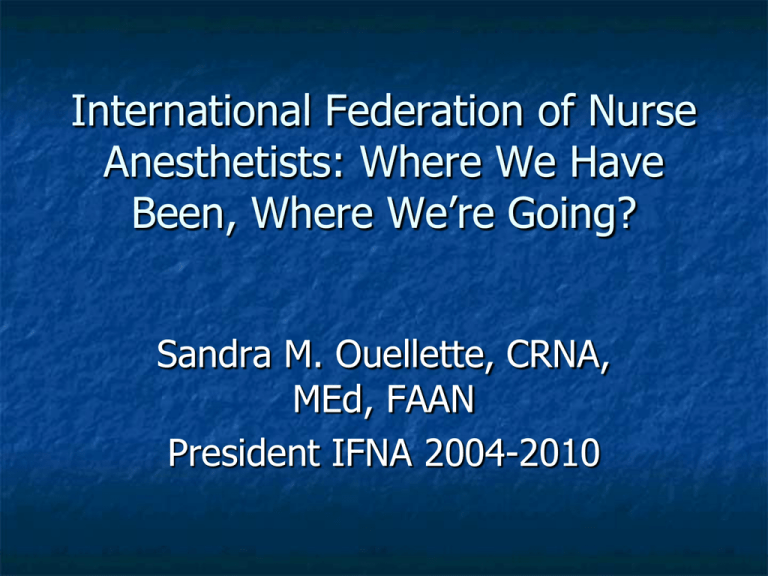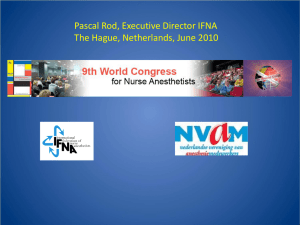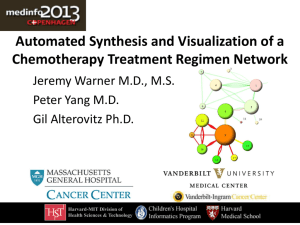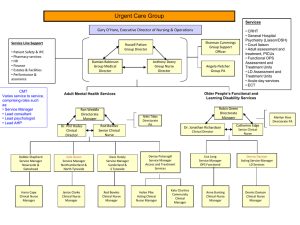The International Federation of Nurse Anesthetists (IFNA): Its Value
advertisement

International Federation of Nurse Anesthetists: Where We Have Been, Where We’re Going? Sandra M. Ouellette, CRNA, MEd, FAAN President IFNA 2004-2010 Historical Development of IFNA 1978 Jan Frandsen (Denmark) and Hermi Lohnert (Switzerland) attend AANA Annual Meeting 1985 First international symposium held Lucerne, Switzerland 250 nurse anesthetists 11 countries 1988 Second international symposium held in Amsterdam 511 nurse anesthetists 16 countries 1988 September first organizational meeting held, Teufen, Switzerland Historical Development (cont.) 1989 May Sandy Maree and Ron Caulk attend ICN 19th Quadrennial Congress in Seoul, Korea June country representatives met in Tuefen, Switzerland to adopt bylaws; 11 charter countries accepted Charter signed on June 10, 1989 World Congress Nurse Anesthetists 1991 Oslo, Norway with 1,100 participants 1994 Paris, France with 2,606 participants 1997 Vienna, Austria with 1,646 participants 2000 Chicago, USA with 4,384 present 2002 Helsinki, Finland with 1,047 present 2006 Lausanne, Switzerland with 1278 present Objectives of IFNA To promote cooperation between nurse anesthetists internationally To develop and promote educational standards in the field of nurse anesthesia To develop and promote standards of practice in the field of nurse anesthesia To assist nurse anesthetists’ association improve standards and competence of nurse anesthetists To promote recognition of nurse anesthetists To promote cooperation among all in health care community Functions of the International Federation of Nurse Anesthetists To promote continual high quality patient care To serve as the authoritative voice of nurse anesthetists and nurse anesthesia internationally To provide a means of communication among nurse anesthetists throughout the world To promote the independence of the nurse anesthetist as a professional specialist in nursing To advance the art and science of anesthesiology IFNA Member Countries and Year of Admission *Austria (1989) Gabon (1994) Jamaica (1997) *South Korea (1989) Belgium ( 2009) *Germany (1989) Luxembourg ( 2005) Spain (1992) Benin (1994) Ghana (1993) Cambodia (1997) Great Britain(1995) Netherlands (1995) *Switzerland (1989) Croatia (1999) Hungary (1999) Nigeria (1993) Taiwan (1999) Democratic Republic of the Congo (1992) *Iceland (1989) *Norway (1989) Uganda (1996) Poland (1998) *United States (1989) Denmark (1997) . Indonesia (2006) Morocco (1997) *Sweden (1989) Educational Activities of IFNA Educational Standards: 1990; revised 1999 Practice Standards:1991; revised 1996 Code of Ethics: 1992 Guidelines for Starting a Nurse Anesthesia Program Monitoring Guidelines Teachers Session ( IFNA International Standards are endorsed by the International Council of Nurses (ICN) 2002 Liaison With Other Organizations European Economic Community (EU) International Council of Nurses (ICN) World Health Organization (WHO) Center for Quality Assurance in International Education (CQAIE) World Federation of Societies of Anaesthesiologists (WFSA) International Hospital Federation International Society for Quality in Health Care IFNA Recognized By International Council Of Nurses There are 7 nursing organizations with ICN affiliate status: 1European Federation Of Nursing Associations (EFN) 2 Council on International Neonatal Nurses (CINN) 3 International Federation of Nurse Anesthetists (IFNA) 4 International Federation of Perioperative Nurses (IFPA) ICN’s Affiliate Nursing Organizations 5 International Society of Nurses in Cancer Care (ISNCC) 6 International Skin Care Nursing Group (ISNG) 7 World Federation of Critical Care Nurses (WFCCN) IFNA Education And Research Foundation Collaborative study of IFNA (Dr Maura McAuliffe) and World Health Organization: 1996 and 1999 1Nurses administer anesthesia in 107 countries 2 Provide 77% in rural areas and 75% in urban areas of the world. 3 57% reported they were required to have a physician anesthetist present (mostly European countries) 4 All had a formal educational program but some were outside the country 5 50% reported continuing education was not available 6 74% reported hospital policies as well as governmental regulation (60%) guide the practice of nurse anesthesia. IFNA Education And Research Foundation 1 Supported a collaborative program with the World Federation Society of Anesthesiologists in Malawi, Africa in 1999. 2 Provided a seminar in Kumasi, Ghana for over 100 nurse anesthetists in 2005 IFNA: Accomplishments, Needs, Its Future The Future IFNA Education Committee: Anesthesia Program Approval Process WCNA 2010 The Hague, The Netherlands June 4-7, 2010. WCNA 2012 Slovenia; 2014 Tunisia History Book marking 20th Anniversary of IFNA: 1989-2009 Appointment of An IFNA Practice Committee IFNA’s Anesthesia Program Approval Process: APAP Betty Horton CRNA, PhD Chairperson IFNA Education Committee IFNA’s Belief “ If nurses are utilized for preoperative or postoperative preparation of the patient and if they perform venous and arterial cannulation, induction and emergence of anesthesia, intubation, and extubation, and if they are left alone for any reason, they should be appropriately educated.” IFNA’s Belief “ If nurses are being utilized in such a manner…IFNA is concerned that their educational process is sufficient to support anesthesia practice and patient safety.” Professional Study & Resource Guide For the CRNA Philosophy of APAP “IFNA believes that it is possible to improve the health and welfare of humanity by promoting international educational standards for nonphysician anesthesia programs. Based on this belief and for the purpose of program approval. It is the policy of IFNA to approve programs that admit students who are nurses or who are educated in another scientific area which prepares students to succeed in their anesthesia education.” Philosophy Of APAP “Although IFNA strongly supports a nursing background for admission, it also believes in an approval process that recognizes the differences that currently exist in the educational preparation of health professionals worldwide that have contributed to nurses and non-nurses being enrolled in anesthesia programs.” Philosophy of APAP “IFNA believes that an inclusive process provides the greatest opportunity to improve anesthesia care to patients now and in the future.” APAP Operational Policies Eligibility Criteria Applications Programs can apply for one of 3 categories: Registration Recognition Accreditation Three Categories Of Approval Recognizes 1 Diversity of nurse anesthesia programs throughout the world; 2 The economic stage of development of a country; 3The resources available to individual programs; 4 A commitment of diverse programs to a common standard of educational quality. Process To Develop APAP First draft of application process developed by Education Committee with members from Switzerland, Africa, Taiwan, Sweden & USA. Three programs completed the pilot project and were awarded “Recognition.” 1 Sweden 2 The Netherlands 3 USA Goals OF APAP To encourage programs to comply with IFNA’s Educational Standards for Preparing Nurse Anesthetists through an approval process that takes cultural differences into consideration. To improve the health and welfare of humanity by promoting international educational standards. To categorize educational preparation and scope of practice throughout the world. IFNA Practice Committee Objectives Define the scope of practice in IFNA member and nonmember countries. Define required credentials to practice as a nurse anesthetists and identify regulatory body responsible. Identify various payment models for anesthesia services in member and nonmember countries. Practice Committee Objectives Continued Develop a model for continuing education for nurse anesthetists. Review and revise Practice Standards and Ethical Standards as needed. Work with the IFNA Education Committee to identify speakers and topics to CPC for all future congress. Financial Status Of IFNA Stable now since dues were adjusted in 2004. We should, however, approach the future with cautious optimism: 1 Must fund congress more often with a two year cycle. 2 Congress may be successful or fail; ie Volcanic eruption in Iceland 3 Unstable world economy Action Steps For Establishing A Global Profession Act as an international witness for the need for professional standards in nurse anesthesia. Interact effectively with appropriate regional and international organizations Act as a liaison to other globalizing professions. Action Steps For Establishing A Global Profession Continued Consider the development of an IFNA quality assurance process for nurse anesthesia educational and professional development programs. Monitor and record its own progress through research, publication, and international forums. Dr Marjorie Peace Lenn Executive Director CQAIE (1997) IFNA Relationships “ Moving ahead to be the best, reaching behind to help the rest”








